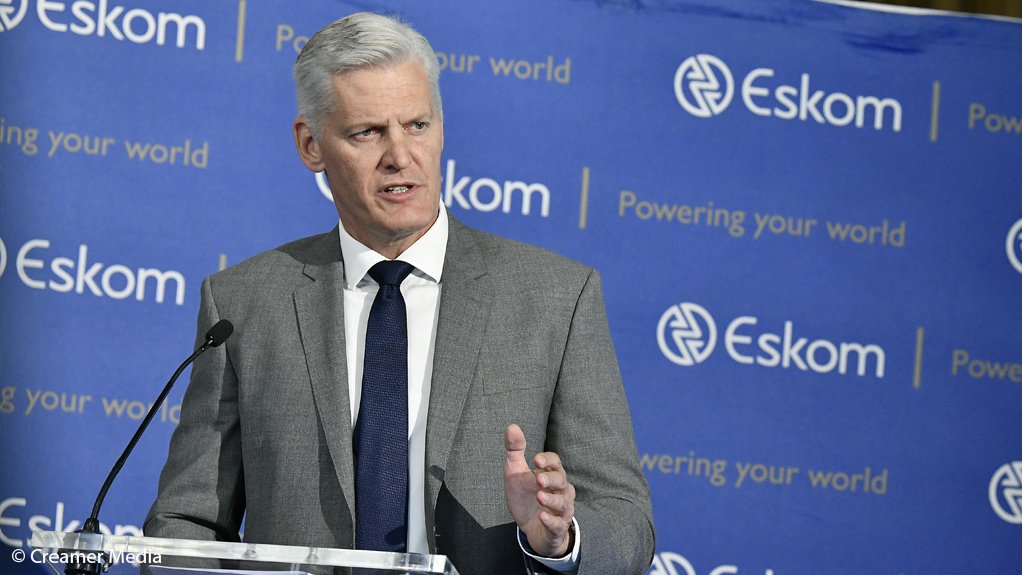Eskom CEO Andre de Ruyter has drawn a direct link between securing the investment required to address South Africa’s growth-sapping electricity supply gaps – including some R100-billion to further develop the grid in ways to unlock what will be mostly private generation investment – and the creation of an Independent Transmission System and Market Operator (ITSMO).
Speaking during a webinar on Thursday, De Ruyter stressed that private investment in generation “requires independence in transmission and market operation” to overcome concerns of potential bias in areas such as grid and market access, dispatch instructions and procurement decisions.
Such bias could hamper efforts to close what was already a “significant” deficit in supply, which had increased the risk of load-shedding, and that was set to expand materially as Eskom moved to retire some 10 000 MW of old coal-fired generation capacity between 2020 and 2030.
De Ruyter praised the recent progress made in approving Ministerial determinations designed to ensure the procurement of 11 800 MW of new generation capacity, which, given the urgency, presupposed a massive deployment of wind and solar generation, which could be built in between 18 and 36 months.
By contrast, De Ruyter noted that new coal and nuclear capacity, which was also far more costly when measured on the basis of a levelised cost of energy, could take anywhere between 10 to 12 years to construct in the case of coal and 12 and 15 years for a new nuclear plant.
The inevitable roll-out of renewables would, thus, require a R100-billion investment for the building of some 8 000 km of new power lines between 2021 and 2030, so as to extend the grid to areas where the wind blows most strongly and where the sun shines most intensively.
De Ruyter expressed confidence in the ability of Eskom to raise green finance for that grid investment, but said doing so would require there to be a direct link to South Africa’s divestment from fossil fuels and its expansion of renewables.
To secure much needed investment from renewables independent power producers (IPPs), however, the creation of a standalone ITSMO had to be prioritised and accelerated.
Speaking on the same platform, organised jointly by Nedbank, EE Business Intelligence and the Joburg Centre of Software Engineering, Public Enterprises Minister Pravin Gordhan stressed government support for the ITSMO.
The Minister described its creation as one of the key “structural reforms” being pursued to address the country’s electricity crisis and create the platform for reliable and affordable electricity in future.
Gordhan said that government was also supportive of the phased approach that had been adopted by Eskom to introduce the ITSMO in line with the Roadmap for Eskom, published by the Department of Public Enterprises in October 2019.
De Ruyter indicated that the transmission entity would be functionally separated from Eskom’s generation and distribution units by the end of March 2021, with full legal separation planned for December 2021.
Integrating the market operator to form a Transmission System Operator would take until December 2022, however, while the creation of a standalone ITSMO was dependent on several legislative and regulatory approvals outside of Eskom's direct control.
University of Cape Town Graduate School of Business’s Power Futures Lab professor emeritus Dr Anton Eberhard said the unbundling of Eskom and the creation of the ITSMO would represent the most profound reform of the South African electricity sector since the creation of Eskom nearly 100 years ago.
“An ITSMO establishes a transparent and fair platform for the competitive procurement of least-cost power, removes Eskom’s conflict of interest . . . and sets the industry on a new path, with more diversification, competition and private sector investment,” Eberhard said.
EMAIL THIS ARTICLE SAVE THIS ARTICLE ARTICLE ENQUIRY
To subscribe email subscriptions@creamermedia.co.za or click here
To advertise email advertising@creamermedia.co.za or click here











